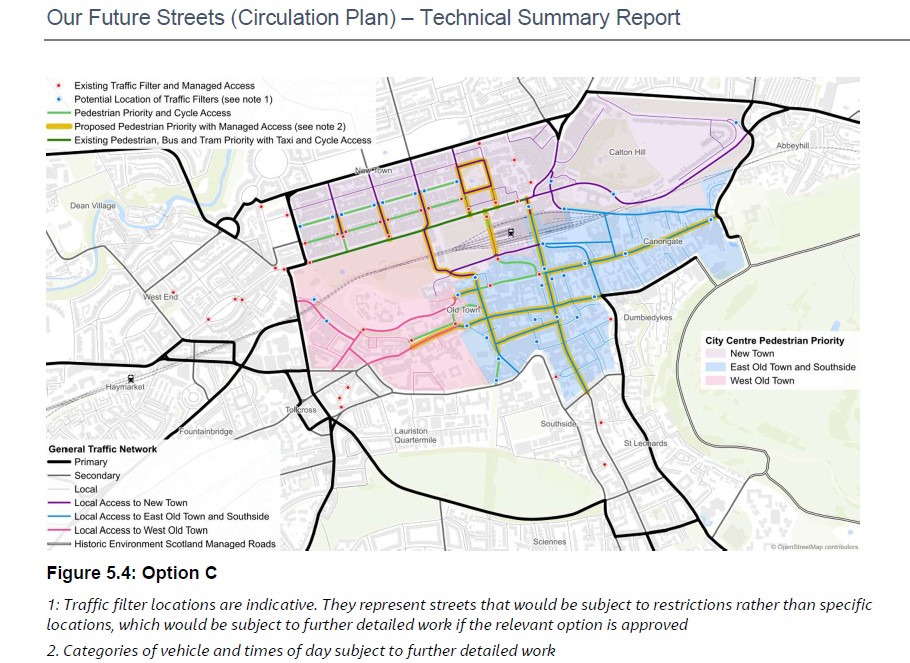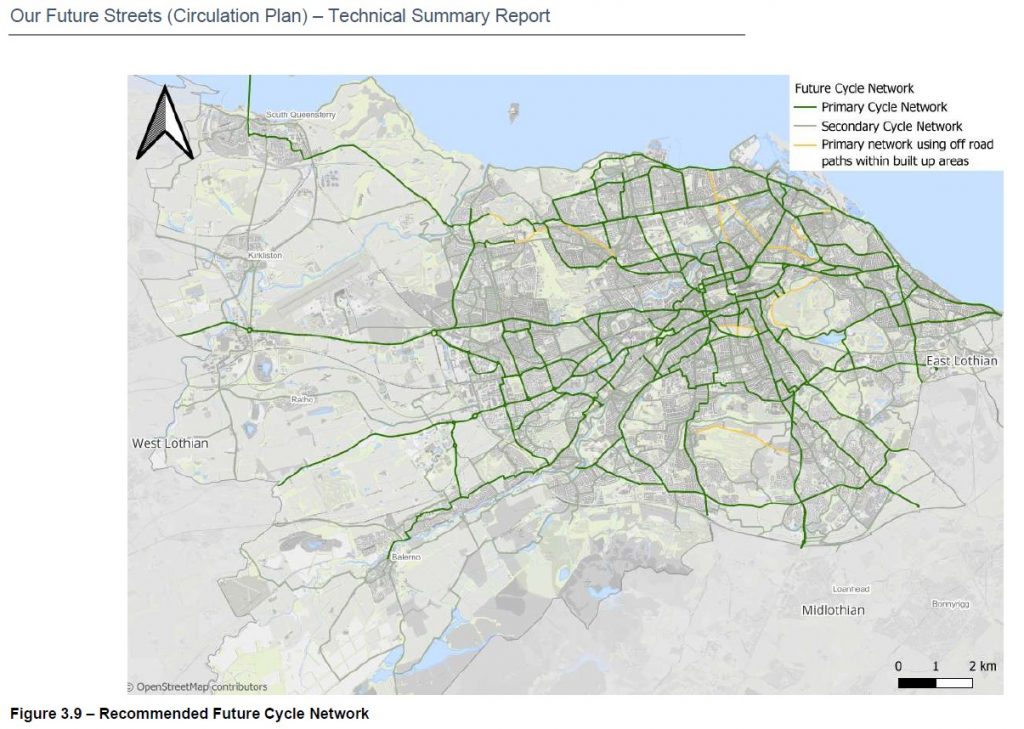On February 1st the Transport Committee approved the ‘Future Streets’ policy, which incorporates the Circulation Plan (deciding which transport modes will have priority on which roads), the Active Travel Action Plan (ATAP), and the City Centre Transformation (to free the City Centre from through motor traffic). Although much detail is still to come, and there will be future consultation on some aspects, transformative basic decisions have now been taken and action can and must begin.
As a city centre token of action-intent, motor traffic will be wholly or largely banned in the Cowgate in 2024.
For main roads, detailed plans will be drawn up for bus and cycle priority on the A8 from CCWEL at Roseburn through to Gogar, with St John’s Road due to become a pedestrian-friendly shopping street. We had suggested this route as a priority in our comments [para 3.3] on the 2023 ATAP consultation, and a Council analysis in the report confirms that it is indeed a priority.
However, for a city with a target to cut car-km 30% by 2030, and become net zero by 2030, things need to move far faster than one or two individual schemes each year. The decade-long gestation of CCWEL or of George Street (see ‘maxi-consultation’ section here), must no longer be the pattern.
Our public meeting on Thursday 29 Feb gives you the chance to hear more and to tell the Council what you think.
Speakers
- Cllr Scott Arthur City Council Transport Convener – the Future Streets policy, with particular reference to the place of cycling, and when/how action will follow
- Laura Laker Cycling, transport and environment journalist – to critique the proposals. Laura researches and writes on cycling issues extensively, including in national/international media such as The Guardian and Bloomberg; and in specifically cycling publications such as Cycling Industry News and Road.CC
- … followed by our always-anticipated one-hour panel QA, chaired by Ewen Maclean, organiser of Blackford Safe Routes – your chance to interrogate and challenge the speakers
Arrangements
- Where Augustine United Church 41 George IV Bridge, Edinburgh EH1 1EL
- Date Thursday 29 February
- Time Starts 7.30, Ends 9.30. Doors open 6.45 for coffee, stalls and chat, including a special stall to join Spokes or renew your membership
- Questions Questions for the speaker, can be emailed (at least a day in advance) to spokes@spokes.org.uk. However, questions in person from audience members are likely to have greatest priority on the night
- Online We hope to live broadcast on our youtube channel – confirmation nearer the time – and make the recording available a few days later
- Social media If tweeting/posting about the meeting, use hashtag #SpokesMtg
- More info If you have any queries about the meeting, email spokes@spokes.org.uk or phone Emma, 07982278936.
Your help needed
Please help publicise our public meeting by passing on the link to this article, liking on facebook and retweeting here.
Background – the new ‘Future Streets’ documents
The (massive) Future Streets documents were released as reports for the Feb 1st Transport Committee. Our twitter thread on the meeting is here. The main documents are…
- 7.1 City Mobility Plan 1st Review This includes the entire Active Travel Action Plan (ATAP) as appendix 6 !
- 7.2 Our Future Streets a circulation plan for Edinburgh and part2 Including what modes will have priority on what streets; ‘liveable neighbourhoods’; a proposed cycleroute network map; and a much-strengthened City Centre Transformation. See here (para 2402) for relevant maps in hi-res.
- 7.3 Tram from Granton to BioQuarter and Beyond: Consultation for Strategic Business Case Development Included the proposal to ‘discourage’ cycling on 2km of the North Edinburgh Network (although, bizarrely, it is part of the cycleroute network map in 7.2 above!!)
Reports 7.1 and 7.2 were agreed by the Committee, though with some amendments. However on 7.3, the north-south tramline, the Committee took a different view of what should be in the consultation (more info in our tramline paragraph below).
Background – Central issues
Given the 2030 targets (above), and in turn their origin in the climate emergency, as well as the context of a fast increasing population in the city and the Lothians, rapid action is essential. This thread provides a useful top-level overview, and there’s a discussion in the 5.2.24 edi.bike newsletter.
In somewhat more detail, here are some of the main issues you may wish to think about and to raise at the meeting…
- City Centre – Unlike the initial version of the City Centre Transformation (much of which fell badly behind schedule) the new plans agreed at the Committee include exciting proposals to remove through traffic from the city centre (diagram below): “create an extensive area between Lothian Road, Lauriston Place, Holyrood Park and Queen Street without general through / car traffic”. But … will these proposals be introduced in stages or in a ‘oner’ – and when? There will undoubtedly be teething problems whichever approach is used, but the incremental approach could be very messy, with interim problems arising that might anyway disappear once the scheme is complete. The city of Ghent took the all-in-one approach, preceded by extensive publicity, and with considerable success, as was explained at Transport Committee. And, indeed, Edinburgh has just adopted a similar courageous approach over the pavement parking ban: no other Scottish Council has yet said they will enforce the ban, which some have portrayed as ‘war on the motorist,’ but in Edinburgh a massive and effective advance publicity campaign has largely ended pavement parking with remarkably little blowback.

- Lothian Road – The City centre proposals remove north-south general traffic from North Bridge and the Mound. Council modelling, however, suggests this would grow traffic considerably on Lothian Road and the western section of Queens Drive in Holyrood Park. How will this be resolved? Car-Free Holyrood highlighted the latter at the Transport Committee. And what of the proposed ‘Lothian Road Boulevard‘ with its segregated cycle lanes and promised safer design of the West End fatality junction? Spokes traffic counts show Lothian Road to be an important cycleroute already, with bikes forming 15%-20% of all vehicles citybound in the morning rush hour.
- Arterial roads – The Committee agreed to draw up exciting plans for the A8 corridor, “an integrated street upgrade as a key corridor from Roseburn to Gogar, incorporating a transformation of St Johns Road as a shopping street for people, better provision for people walking/wheeling, protected cycling infrastructure and measures to improve bus journey times and reliability.” However, no timescale was given, and Scottish Government or other funding is still to be achieved. Use of Experimental Traffic Orders (ETROs) could however prevent the delay of perhaps a year (or much more) experienced by many past traffic schemes, so that conceivably the project could happen in 2025. In any case, however, given the 2030 deadlines, multiple routes need to be tackled urgently. One expert said, “For the cycle network, this almost certainly means looking at much, much wider/routine application of quick/cheap/adaptable light segregation.” For example, like the Spaces for People and/or Holyrood Road designs, and with careful thought to design at bus stop bypasses & junctions.
- 20-minute neighbourhood strategy – aiming to “improve sustainable and active travel access to services and facilities across the city.” The main aim of individual schemes would be “to deliver streets, pavements and places that allow everyone to get around easily locally, improving peoples’ health and wellbeing.” Already two schemes are in place under Experimental Traffic Orders, Leith Connections and Corstorphine Connections and others are being developed including Gorgie/Dalry, Portobello, Wester Hailes, Craigmillar/Bingham. However, given the violent reaction by a minority to some traffic restrictions the document is hesitant on such measures, “issues of intrusive through traffic would also be addressed where there is local support, as would measures such as crossings to help deliver cycling quiet routes.” So this strategy’s effectiveness, and timescale, in improving “active travel access to facilities across the city” is not yet clear.
- Cycleroute network and Active Travel Action Plan (ATAP) Rather than being a document in its own right, the new ATAP is now Appendix 6 of the Mobility Plan report (7.1 above) – we don’t know if it will be published separately also. Given the mass of documentation, Spokes has not yet scrutinised the new ATAP in detail to see how far our consultation comments have been incorporated. However, we strongly welcome the intention that the ‘Primary Cycle Network’ should be largely segregated routes on main roads. Most of Edinburgh’s often excellent offroad network is now called ‘secondary;’ this is not to downgrade its value but to recognise that its role is different to the primary network: as linking routes, connections to local areas, some remaining main connections, and of course a significant recreational purpose. The network map (below) appears in both ATAP (page 22) and the Future Streets Circulation Plan (page 28). Again, we have not yet scrutinised this carefully, but although welcoming the overall approach there are some concerns, particularly regarding our consultation point that the segregated onroad network should be fully connected. The rationale given by the council for not always achieving this is in 4.15 of report 7.2, the Circulation Plan, namely…
- “To account for the impact that providing segregated space for cycling would have on place, walking/wheeling or public transport; and
- To take account of streets where there is insufficient space for segregation, regardless of what other changes are made – this has resulted in many sections of route being amended from primary to secondary” (i.e. non-segregated?)

- Tramline extension, Granton to Bioquarter and beyond – paper 7.3 above. Spokes put a great deal of effort into this issue during the runup to the Transport Committee (TEC), since immediate decisions were to be taken on the contents of the forthcoming consultation. See our pre-TEC article and, following our campaign, this post-TEC. And – thank you if you contacted your councillors as a result our campaign! Of course, the decision was merely about what would be in the consultation – you and we will doubtless need to do more in future, to ensure the best consultation outcome and the best eventual outcome on the ground.
